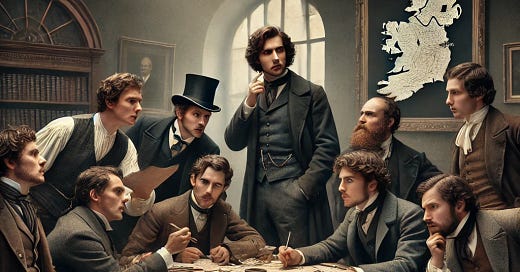The Young Ireland movement was a radical and intellectual force that emerged in the 1840s, advocating for Irish self-governance, cultural revival, and national identity. While often overshadowed by Daniel O’Connell’s Repeal Association, Young Ireland played a crucial role in shaping the political discourse of the time. Their ideas and actions left a lasting impact on Irish nationalism, setting the stage for later movements such as the Irish Republican Brotherhood and the Easter Rising of 1916.
Origins of Young Ireland
Young Ireland was formed as a faction within the broader Repeal Association, led by Daniel O’Connell, who sought to overturn the 1801 Act of Union between Britain and Ireland. The movement was spearheaded by a group of young intellectuals and journalists, many of whom were associated with The Nation newspaper. Founded in 1842 by Charles Gavan Duffy, John Blake Dillon, and Thomas Davis, The Nation became the voice of Young Ireland, spreading nationalist ideas through poetry, prose, and political essays.
Unlike O’Connell’s peaceful and gradualist approach, Young Ireland sought a more assertive and independent stance. They believed in a fusion of political agitation with cultural revival, emphasizing the importance of Irish history, literature, and language in shaping national identity. Their writings inspired a generation of Irish people to view their country as a distinct nation rather than a province of the British Empire.
Key Figures and Ideologies
The movement was not monolithic; it consisted of diverse thinkers who contributed to its philosophy in different ways.
Thomas Davis: Perhaps the most influential intellectual of Young Ireland, Davis believed in a non-sectarian nationalism that united Catholics and Protestants under the banner of Irish identity. His writings, including the famous poem A Nation Once Again, inspired many with their emphasis on Irish cultural pride.
John Mitchel: A radical journalist who later broke away from Young Ireland, Mitchel was an outspoken advocate of physical force nationalism. He argued that Ireland would never gain independence through parliamentary means and promoted the idea of armed insurrection against British rule.
Charles Gavan Duffy: As the founder of The Nation, Duffy played a crucial role in spreading the movement’s ideas. He initially supported constitutional means of achieving Irish self-government but later became disillusioned with O’Connell’s leadership.
William Smith O’Brien: A former supporter of O’Connell, O’Brien eventually aligned with Young Ireland and led the ill-fated 1848 rebellion. He embodied the movement’s transition from intellectual activism to direct action.
While Young Ireland’s members agreed on the need for an independent Ireland, they were divided on how to achieve it. Some favored peaceful constitutional agitation, while others leaned toward revolutionary action.
The Split with O’Connell
The tension between Young Ireland and O’Connell’s Repeal Association reached a breaking point in 1846. The dispute was primarily over the use of physical force in the struggle for Irish self-rule. O’Connell, committed to peaceful methods, condemned any suggestion of armed resistance. In contrast, many within Young Ireland believed that violence might become necessary if constitutional means failed.
The final rupture came when Thomas Meagher, a prominent Young Irelander, defended the right of a nation to resist tyranny with arms. O’Connell’s followers accused Young Ireland of betraying the principles of the movement, leading to their expulsion from the Repeal Association.
The 1848 Rebellion and Its Aftermath
Inspired by the wave of European revolutions in 1848, Young Ireland attempted an armed uprising against British rule. Led by William Smith O’Brien, the rebellion was poorly organized and quickly suppressed. The infamous "Battle of Widow McCormack’s Cabbage Patch" in Ballingarry, County Tipperary, marked the movement’s military failure.
Many of Young Ireland’s leaders were arrested and sentenced to transportation to penal colonies in Australia. John Mitchel, the most radical of them, was convicted of treason and exiled. Others, like Charles Gavan Duffy, later pursued careers in politics and journalism.
Despite its failure as a revolutionary force, Young Ireland’s impact endured. Their emphasis on Irish cultural identity and national pride influenced later movements, including the Fenians and the Irish Republican Brotherhood.
Legacy of Young Ireland
Though the 1848 rebellion failed, Young Ireland succeeded in redefining Irish nationalism. Their contributions can be seen in several key areas:
Cultural Revival: The movement laid the foundation for later efforts to preserve the Irish language, history, and folklore, inspiring groups like the Gaelic League.
Political Radicalization: Young Ireland introduced a more assertive form of nationalism that rejected reliance on British goodwill, paving the way for future uprisings.
Influence on Later Leaders: Figures like Patrick Pearse and Éamon de Valera drew inspiration from Young Ireland’s writings and ideals.
Journalism as a Weapon: The Nation set a precedent for using the press to mobilize public opinion, a strategy later employed by the Irish Republican movement.
Conclusion
Young Ireland was more than just a political movement; it was a revolution of thought that inspired generations to strive for an independent Ireland. Although they did not achieve their immediate goals, their legacy lived on in Ireland’s struggle for freedom. By blending cultural pride with political activism, they left an indelible mark on Irish history, proving that nationalism is not just about borders but about identity, language, and heritage.




